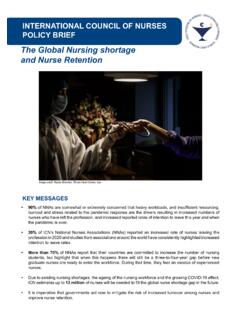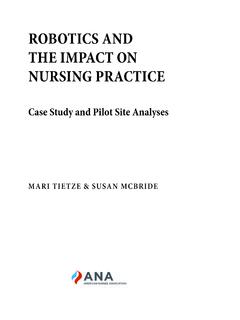Transcription of Global Recommendations for EPA and DHA Intake (Rev 19 ...
1 Page 1 of 25 Global Recommendations for EPA and DHA Intake (Rev 19 November 2014) Country/Region Organization Org. Type Target Population Recommendation Publication Date Global World Health Organization (WHO)1 Authoritative Body General adult population n 3 PUFAs: 1 2% of energy/day 2003 Food and Agriculture Organization of the United Nations (FAO)2 Authoritative Body 0 6 months DHA: 2008 6 24 months DHA: 10 12 mg/kg bw 2 4 years EPA + DHA: 100 150 mg 4 6 years EPA + DHA: 150 200 mg 6 10 years EPA + DHA: 200 250 mg Pregnant/Lactating Women EPA + DHA: g/d of which at least should be g/d International Society for the Study of Fatty Acids and Lipids (ISSFAL) Expert Scientific Organization General adult population for cardiovascular health3 at least 500 mg/day of EPA+DHA 2004 Pregnant/Lactating Women4 DHA: 200 mg/day 2007 NATO Workshop on 3 and 6 Fatty Acids5 Workshop General Adult Population 300 400 mg EPA+DHA/day 1989 World Association of Perinatal Medicine6 Working Group Pregnant and Lactating Women 200 mg DHA/ day 2008 Infants, when breastfeeding is not possible wt total fat World Gastroenterology Organisation7 Expert Scientific Organization General Adult Population 3 5 servings/wk of fish 2008 Australia National Heart Foundation of Australia8 Expert Scientific Organization General adult population to lower risk of CHD 500 mg EPA + DHA per day, obtained through fish, fish oil capsules, or enriched foods & drinks 2008 Patients with documented CHD 1000 mg EPA + DHA per day, obtained through Page 2 of 25 Country/Region Organization Org.
2 Type Target Population Recommendation Publication Date fish, fish oil capsules, or enriched foods & drinks Patients with hypertriglyceridemia 1200mg of EPA + DHA per day, obtained through fish, fish oil capsules or enriched foods & drinks as first line therapy Increase to 4000 mg of EPA +DHA per day, as needed. Australian & New Zealand Health Authorities (Department of Health & Ageing, National Health & Medical Research Council)9 Authoritative Bodies Infants (0 12 mo) g n 3 polyunsaturated fats/day adequate Intake 2006 Boys & Girls (1 3 yrs) 40 mg total LC n 3 (DHA+EPA+DPA) / day adequate Intake Boys & Girls (4 8 yrs) 55 mg total LC n 3 (DHA+EPA+DPA) / day adequate Intake Boys & Girls (9 13 yrs) 70 mg total LC n 3 (DHA+EPA+DPA) / day adequate Intake Boys (14 18 yrs) 125 mg total LC n 3 (DHA+EPA+DPA) / day adequate Intake Girls (14 18 yrs) 85 mg total LC n 3 (DHA+EPA+DPA) / day adequate Intake Men (19+ yrs) 160 mg total LC n 3 (DHA+EPA+DPA) per day adequate Intake Women (19+ yrs) 90 mg total LC n 3 (DHA+EPA+DPA)
3 / day adequate Intake Page 3 of 25 Country/Region Organization Org. Type Target Population Recommendation Publication Date Pregnancy (14 18 yrs) 110 mg total LC n 3 (DHA+EPA+DPA) / day Pregnancy (19 50 yrs) 115 mg total LC n 3 (DHA+EPA+DPA) / day Lactating (14 18 yrs) 140 mg LC n 3 (DHA+EPA+DPA) / day Lactating (19 50 yrs) 145 mg LC n 3 (DHA+EPA+DPA) / day Men Suggested dietary target to reduce chronic disease risk 610mg LC n 3 (DHA+EPA+DPA) / day Women Suggested dietary target to reduce chronic disease risk 430mg LC n 3 (DHA+EPA+DPA) / day Defence Science and Technology Organisation, Australian Government Department of Defence10 Authoritative Body Male soldiers 610mg EPA+DPA+DHA/ day 2009 Female soldiers 430mg EPA+DPA+DHA / day Europe Expert Workshop of the European Academy of Nutritional Sciences11 Expert Scientific Organization General Adult Population People who do not eat fish should consider obtaining 200 mg EPA + DHA from other sources 1998 European Food Safety Authority12 Authoritative Body General Adult Population 250mg EPA+DHA /day 2010 Pregnant & Lactating Women 100 200 mg DHA / day in addition to general adult requirements Children 7 24 months 100 mg DHA / day Children 2 18 years 250mg EPA+DHA /day The PeriLip and EARNEST projects of the European Commission4 Expert Scientific Organization Pregnant & Lactating Women 200mg DHA/day 2007 Fifth Joint Task Force of the Expert General Adult Fish at least twice a 2012 Page 4 of 25 Country/Region Organization Org.
4 Type Target Population Recommendation Publication Date European Society of Cardiology and Other Societies on Cardiovascular Disease Prevention in Clinical Practice (constituted by representatives of nine societies and by invited experts)13 Scientific Organization Population for Cardiovascular Disease Risk Reduction week, one of which to be oily fish. Task Force on the Management of ST Segment Elevation Acute Myocardial Infarction of the European Society of Cardiology14 Expert Scientific Organization Increase consumption of omega 3 fatty acid (oily fish) Supplementation with 1 g of fish oil in patients with a low Intake of oily fish omega 3 supplements should be considered in patients who do not tolerate statins, especially if TG >150 mg/dL ( mmol/L) 2008 Task Force for the management of dyslipidaemias of the European Society of Cardiology (ESC) and the European Atherosclerosis Society (EAS)15 Expert Scientific Organization General Adult Population for Cardiovascular Disease Risk Reduction At least two or three portions of fish per week 2011 Secondary prevention of CVD 1 g/day n 3 unsaturated fats, which is not easy to derive exclusively from natural food sources, and use of nutraceutical and/or pharmacological supplements may be considered The Task Force for the Diagnosis and Treatment of Acute and Expert Scientific patients with symptomatic (NYHA An n 3 PUFAf preparation may be considered to reduce 2012 Page 5 of 25 Country/Region Organization Org.)
5 Type Target Population Recommendation Publication Date Chronic Heart Failure 2012 of the European Society of Cardiology. Developed in collaboration with the Heart Failure Association (HFA) of the ESC64 Organization class II IV) systolic heart failure the risk of death and the risk of cardiovascular hospitalization in patients treated with an ACE inhibitor (or ARB), beta blocker, and an MRA (or ARB) France AFFSA16 Authoritative Body General Adult Population 500 mg EPA + DHA / day 250 mg EPA / day 250 mg DHA / day 2010 Metabolic Syndrome Diabetes Obesity Risk Reduction 500 mg EPA + DHA / day Cardiovascular Risk Reduction 500 750 mg EPA + DHA / day Breast & Colon Cancer Risk Reduction 500 mg EPA + DHA / day Neuropsychiatric Risk Reduction >200 300 mg EPA + DHA / day Age Related Macular Degeneration Risk Reduction 500 mg EPA + DHA / day Infants (0 6 months) of fats from DHA EPA < DHA Infants & Toddlers (6 months to 3 years) 70mg DHA /day Children (3 9 years)
6 125mg DHA /day 250mg EPA+DHA /day Adolescents (9 to 18 years) 250mg DHA /day 250mg EPA+DHA /day Pregnant & Lactating Women 250mg DHA /day 250mg EPA+DHA day Austria Austrian Society for Nutrition17 Expert Scientific General adult population 250mg LCPUFA / day for primary prevention of 2008 Page 6 of 25 Country/Region Organization Org. Type Target Population Recommendation Publication Date Organization CVD General adult population of energy total n 3 PUFA Intake CHD Patients 1g LCPUFA / day for secondary prevention of CVD Pregnant & nursing women At least 200mg DHA / day Germany German Society for Nutrition17 Expert Scientific Organization General adult population 250mg LCPUFA / day for primary prevention of CVD 2008 General adult population of energy total n 3 PUFA Intake CHD Patients 1g LCPUFA / day for secondary prevention of CVD Pregnant & nursing women At least 200mg DHA / day Healthy Start Young Family Network25, 45, 57 Expert Scientific Organization Pregnant women to supply the recommended 200mg/day of DHA, consume 2 servings/wk of marine fish, including at least one serving of fatty sea fish (such as mackerel, Herring, sardines, salmon)
7 Pregnant women who do not regularly consume fish, the use of supplements with the Omega 3 fatty acid DHA is recommended 2012 2013 Page 7 of 25 Country/Region Organization Org. Type Target Population Recommendation Publication Date Switzerland Swiss Society for Nutrition Research / Swiss Nutrition Association17 Expert Scientific Organization General adult population 250mg LCPUFA / day for primary prevention of CVD 2008 General adult population of energy total n 3 PUFA Intake CHD Patients 1g LCPUFA / day for secondary prevention of CVD Pregnant & nursing women At least 200mg DHA / day Poland Polish Gynecological Society60 Scientific Organization Pregnant Women pregnant women at low risk of preterm birth should take at least 600 mg/day DHA pregnant women at high risk of preterm birth should take at least 1000 mg/day DHA 2014 Belgium Superior Health Council of Belgium18 Authoritative Body Pregnant & nursing women 250mg DHA / day 2004 General adult population (primary cardioprevention)
8 Two servings of fatty fish/wk secondary cardioprevention 1g EPA+DHA per day Netherlands Health Council of the NetherlandsAuthoritative Body 0 5 months19 DHA: 20 mg/kg/day 2001 6 11 months19 N 3 fatty acids from fish: 15 20 mg/kg/day 1 18 years old19 N 3 fatty acids from fish: 15 20 mg/kg/day 19 years +19 N 3 fatty acids from fish: 20 mg/kg/day Page 8 of 25 Country/Region Organization Org. Type Target Population Recommendation Publication Date Pregnant women19 N 3 fatty acids from fish: 20 mg/kg/day Lactating women19 N 3 fatty acids form fish: 20 mg/kg/day Adults20 n 3 fatty acids from fish: 450 mg/day 2006 Scandinavia Nordic Council of Ministers21 Authoritative Body 6 11 months n 3 fatty acids should contribute at least 1 E% 2013 12 23 months n 3 fatty acids should contribute at least E% Adults and children from 2 yrs of age n 3 fatty acids should contribute at least E% Pregnant & Lactating Women 1 E% from n 3 fatty acids of which 200 mg/d should be DHA United Kingdom British Nutrition Foundation22 Expert Scientific Organization Adults, 19 50 yrs one to two portions of oil rich fish per week, which will provide around 2 3g of the very long chain n 3 fatty acids weekly Intake of of EPA + DHA 1999 Committee on Medical Aspects of Food Policy (COMA)23 Authoritative Body Adults at least two portions of fish, of which one should be oily, weekly n 3 PUFA Intake .
9 G/day 1994 Scientific Advisory Committee on Nutrition (SACN)24 Authoritative Body Adults at least two portions of fish, of which one should be oily, weekly n 3 PUFA Intake : g/day 2004 National Institute for Health and Authoritative People at high risk of or consume at least two 2008 Page 9 of 25 Country/Region Organization Org. Type Target Population Recommendation Publication Date Clinical Excellence (May 2008)26 Body with CVD portions of fish per week, including a portion of oily fish Joint British Societies27 Expert Scientific Organization General Adult Population Regular Intake of fish and other sources of omega 3 fatty acids (at least two servings of fish per week) 2005 Irish Heart Foundation54 Expert Scientific Organization General Adult Population 200 mg/day long chain fatty acids British Dietetic Association66 Expert Scientific Organization General Population Two Portions per week of fish, one of which should be oily.
10 Equals ~450mg EPA+DHA 2014 National Collaborating Center for Primary Care28 Expert Scientific Organization General Adult Population At least two servings of omega 3 fatty acid containing fish per week 2007 People with Established CVD At least two servings of omega 3 fatty acid containing fish per week week) Italy Italian Ministry of Health52 Authoritative Body Pregnant and nursing Women Vegan women should consume foods rich in DHA 2007 Spain Spanish Society of Intensive Care Medicine and Coronary Units and Spanish Society of Parenteral and Enteral Nutrition29 Expert Scientific Organization Individuals with acute coronary syndrome and patients with chronic heart failure Administration of 1 g/day of omega 3 (EPA+DHA) in the form of fish oil can prevent sudden death in the treatment of acute coronary syndrome and can also help to reduce hospital admission for cardiovascular events in 2011 Page 10 of 25 Country/Region Organization Org.





